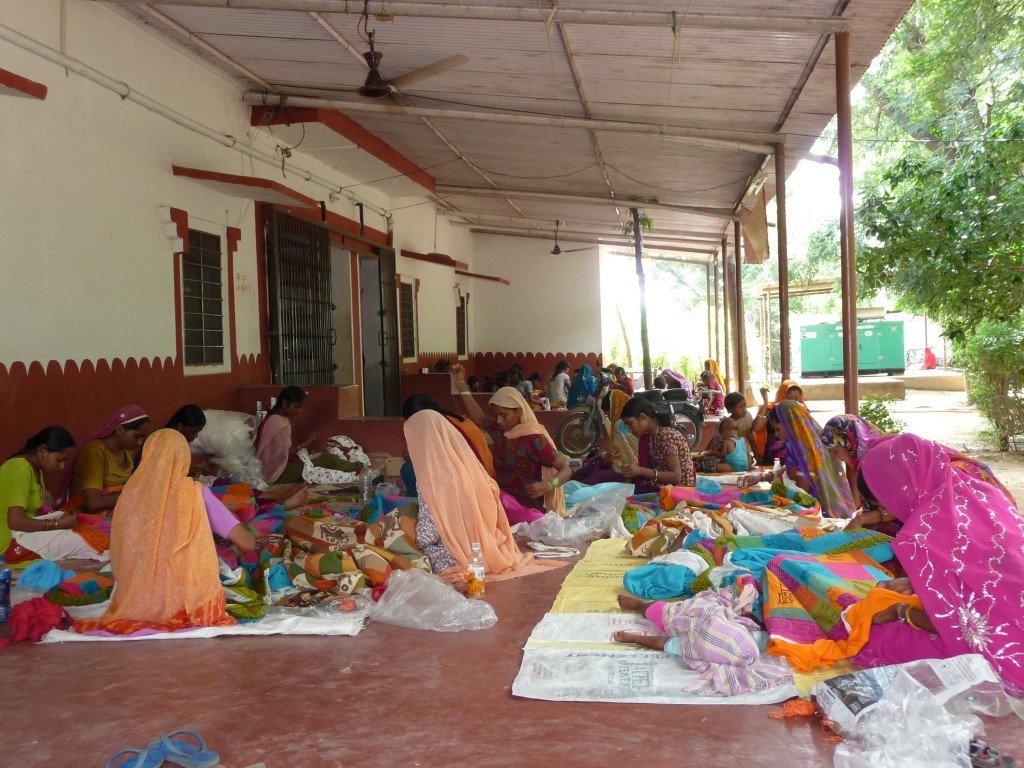
1 May, 2015
India traditional crafts set to fall into hands of powerloom lobbies
Bengaluru, (Media release from the NGO Equations) — With the move to repeal The Handlooms (Reservation of Articles for Production) Act, 1985, there is yet another attempt at mechanising the traditional crafts forms, that would eventually render lakhs of artisans jobless. The argument of the powerloom lobbies is that the same textile product, like a saree, can be made faster, cheaper and at a larger scale. The move is ignorant of the fact that the historical and glorious skills that artisans have, will be rendered obsolete by mechanical alternatives that produce cheaper, but employ far fewer people in a country where power is scarce and labour abundant. More importantly, the soul of the traditional skills and artforms would be lost forever.
 Women in Rajasthan working on hand-embroidered quilts in co-operatives |
Interestingly, in the globalised world, the growth in world tourism has increased the demand for such ethnic and culture specific goods, making handicrafts an important element of cultural exchange between communities – leather, lacquer, wood, embroidery, textiles, metal – the range is phenomenal. Be it small pieces of jewellery or exquisite wood carvings, the thing that makes every tourist reminisce of a trip are more often than not, the result of an ancient history of craftsmanship and endless hours of toil.
According to the Survey of Foreign Tourists Expenses (2002) undertaken by the Ministry of Tourism, craft products form an important part of the purchase made by tourists. 2013 trends show that the sheer volumes of both the domestic (1145.28 mn) and foreign (6.97 mn) tourists, have the potential to significantly contribute in creating a large market for handicrafts in tourism. Many tourists upon finding good artisans, have been known to place bulk orders or even forge business relations.
Apart from the economics, handicrafts have provided a window for people to have a glimpse of the rich legacy and culture of the communities. Just like the enmeshing of threads in the handlooms, the arts and crafts are intricately woven into the lives of the artisan communities. The involvement of people as labour is also special, where the end product is not only a means for livelihood, but an expression of one’s being, socio-cultural background, economic and environmental constraints and opulences. Due to this understanding, large number of tourists are drawn to various destinations exclusively to explore the handicrafts, giving rise to “craft tours” – where tourists not only understand the technicalities of the artform, but the entire realm of its evolution and their makers.
In various tourist destinations, the visitors have access to the houses of the artisans, where they can watch a demonstration of their work, and buy pieces from the makers themselves, adding to the authenticity of a tourist experience. Mass tourists, on the other hand, bound by the tight schedule of tour-packages, have little intention of spending time or effort on engaging with the artisans. The preoccupation is to acquire a bag full of knick-knacks for family and friends, and they walk away feeling content that they have bought a slice of that place.
However, for the artisans, the picture is not so rosy. Artisans all across the country face problems of accessing raw materials at a cheap rate and lack of adequate credit facilities. The problem is more acute in a tourist destination, where the larger demand is for cheap and small souvenirs among the travellers, which forces the artisans to alter traditional products to fit the market and compromise on the quality of craftsmanship to produce large numbers at cheap rates. A wide-spread phenomena is of middlemen holding the artisan to ransom in tourist destinations – lest the artisan pays exorbitant rates of commissions, the customer base of tourists would be significantly hampered. With growth of tourism and subsequent rise in demand of handicrafts, often there have been traders/ sellers who sell mechanised versions of the same handicrafts making false claims about their source, and hence creating a false image of the artworks in the minds of the tourists. The irony of tourism has been that it feeds on the unique cultural settings of the destinations, and the business of it has usually led to the erosion of the same. Thus, in a tourist destination, an artisan is not only fighting for a livelihood, but also to protect his/ her legacy.
Given the close linkage between tourism and souvenir products, the tourism sector holds huge potential for marketing and publicity of handicrafts. This linkage is crucial, as it creates awareness about art-forms and their makers within communities that they are traditionally not linked to. However, the labour which requires special skill, talent and sensibilities in terms of the aesthetic and artistic value of the end-product, is not as valued as the product in itself. The tourism industry needs to recognise the labour of the artisans in the destinations, and the art as a way of their life.
If local artforms are being co-opted as tourism products, then there should be provisions for the same artisan to have democratic space for decision making processes in tourism. He/she should have the right to dignified conditions of labour and not be reduced to being puppets for demonstration in their own houses. The government should recognise and acknowledge artisans’ work as contributing to the tourism industry. It should be accountable to the artisans by ensuring that promotional material portray sensitive imagery and information and that tourism policy and governance protect their interests and rights.
EQUATIONS is a research and advocacy organisation working on the social, cultural, economic and environmental impacts of tourism on local communities (www.equitabletourism.org)



Liked this article? Share it!